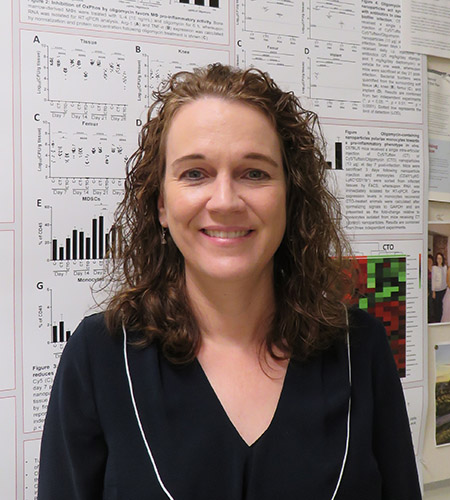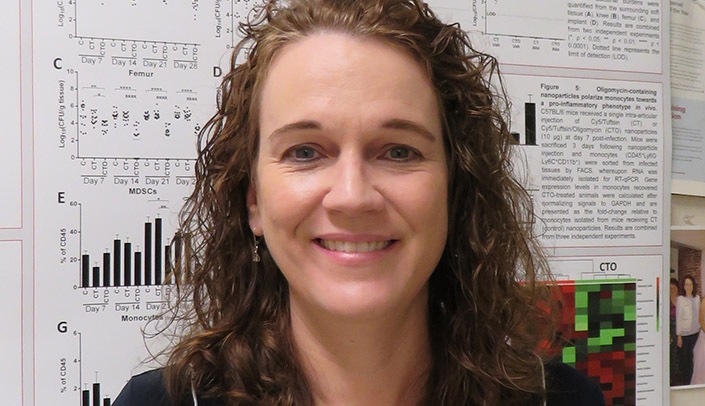 |
Tammy Kielian, PhD |
Imagine having hip or knee replacement surgery then needing to have it redone due to infection that sets in. Infections can result in additional surgery and hospitalization, considerable disability and prolonged recovery, as well as cost.
Staphylococcus aureus (S. aureus) is a leading cause of prosthetic joint infection that is characterized by biofilm formation — groups of bacteria that are held together by molecules that help them attach to surfaces, such as the orthopaedic hardware used for hip and knee replacements.
UNMC researchers are working toward another way to treat S. aureus infections in joint replacement surgery besides using antibiotics, which when used alone usually aren’t effective, said Tammy Kielian, PhD, the Choudari Kommineni, DVM, PhD Professor of Pathology, UNMC Department of Pathology and Microbiology.
Dr. Kielian and collaborators have published a study that appears in the October 2020 print issue of Nature Microbiology — one of the leading journals in the field of microbiology.
She said the work is the first to show that a bacterial metabolite is capable of changing the way that immune cells respond to S. aureus biofilm. Findings suggest it might be possible to target the molecule in bacteria to prevent immune suppression, as well as help the immune system to clear an established infection.
“Our study identified a molecule that is produced by S. aureus that promotes the anti-inflammatory activity of immune cells in prosthetic joint infections,” Dr. Kielian said. “We demonstrated this using our mouse model of S. aureus prosthetic joint infection, and also in samples from patients suffering from these infections, demonstrating the potential of our findings to impact human disease.
Hip and knee infections
Hip and knee infections occur in about 1-2% of orthopaedic surgeries, with S. aureus being one of the most common causes. Infection after hip or knee replacement has a significant impact on patients as well as the health care system, with a projected economic burden in excess of $1.62 billion annually.
“S. aureus encodes a vast array of virulence factors that target immune defenses, and the ability to form a biofilm is another example of how it is able to circumvent elimination by the immune system,” she said. “Eradication of established S. aureus biofilm typically requires surgery because antibiotics alone are not usually effective at clearing infection. This is because many of the bacteria in the biofilm are not actively dividing, which is one of the main features used by antibiotics to kill bacteria. These cells are referred to as ‘persisters.'”
Dr. Kielian, who is senior author of the paper, said in addition, the study was the only paper in the October issue that was selected for a “News and Views” highlight, an honor reserved only for top papers considered to have a high impact.

Congratulations to your team Dr. Kielian!
Great work! Thank you for all your team is doing.
Congratulations Tammy – outstanding work!
Congratulations Dr. Kielian and team!